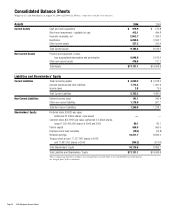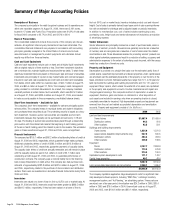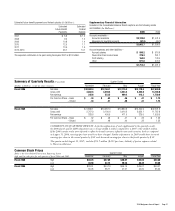Walgreens 2006 Annual Report Download - page 32
Download and view the complete annual report
Please find page 32 of the 2006 Walgreens annual report below. You can navigate through the pages in the report by either clicking on the pages listed below, or by using the keyword search tool below to find specific information within the annual report.
Notes to Consolidated Financial Statements (continued)
Components of net periodic benefit costs (In Millions):
2006 2005 2004
Service cost $18.3 $22.0 $19.3
Interest cost 21.4 23.6 22.5
Amortization of actuarial loss 8.8 10.6 9.9
Amortization of prior service cost (4.1) (3.6) (.4)
Transition obligation —4.9 —
Total postretirement benefit cost $44.4 $57.5 $51.3
Change in benefit obligation (In Millions):
2006 2005
Benefit obligation at September 1 $391.8 $392.5
Service cost 18.3 22.0
Interest cost 21.4 23.6
Amendments (5.0) (36.7)
Actuarial gain (62.7) (6.6)
Benefit payments (9.1) (8.7)
Participants contributions 1.0 .8
Medicare Part D subsidy .3 —
Transition obligation —4.9
Benefit obligation at August 31 $356.0 $391.8
Change in plan assets (In Millions):
2006 2005
Plan assets at fair value at September 1 $— $—
Plan participants contributions 1.0 .8
Employer contributions 7.8 7.9
Benefits paid (9.1) (8.7)
Medicare Part D subsidy .3 —
Plan assets at fair value at August 31 $— $—
Funded status (In Millions):
2006 2005
Funded status $(356.0) $(391.8)
Unrecognized actuarial loss 130.7 203.0
Unrecognized prior service cost (66.1) (65.2)
Accrued benefit cost at August 31 $(291.4) $(254.0)
The measurement date used to determine the postretirement benefits is as of
August 31, 2006 and 2005. The discount rate assumption used to compute the
postretirement benefit obligation at year-end was 6.25% for 2006 and 5.5% for
2005. The discount rate assumption used to determine net periodic benefit cost
was 5.5% for 2006 and 2005, and 6.5% for 2004.
Future benefit costs were estimated assuming medical costs would increase at a
9.25% annual rate gradually decreasing to 5.25% over the next five years and
then remaining at a 5.25% annual growth rate thereafter. A one percentage point
change in the assumed medical cost trend rate would have the following effects
(In Millions):
1% Increase 1% Decrease
Effect on service and interest cost $ .9 $ (1.1)
Effect on postretirement obligation 16.6 (20.1)
The intrinsic value for options exercised in fiscal 2006, 2005 and 2004 was
$173.0 million, $89.3 million and $132.0 million, respectively. The total fair
value of options vested in fiscal 2006, 2005 and 2004 was $116.3 million,
$31.5 million and $36.1 million, respectively.
Cash received from the exercise of options in fiscal 2006 was $176.7 million.
The related tax benefit realized was $66.1 million. The company has a practice
of repurchasing shares on the open market to satisfy share-based payment
arrangements and expects to repurchase approximately eight million shares
during fiscal 2007.
A summary of information relative to the company’s restricted stock awards follows:
Weighted-
Average
Grant-Date
Nonvested Shares Shares Fair Value
Nonvested at August 31, 2005 262,307 $40.96
Granted 92,640 49.46
Forfeited ——
Vested (104,487) 39.50
Nonvested at August 31, 2006 250,460 $44.71
The fair value of each option grant was determined using the Black-Scholes option
pricing model with weighted-average assumptions used in fiscal 2006, 2005
and 2004:
2006 2005 2004
Risk-free interest rate
(1)
4.10% 3.80% 4.07%
Average life of option (years)
(2)
7.2 7.2 7.0
Volatility
(3)
32.12% 28.14% 28.56%
Dividend yield
(4)
.45% .58% .38%
Weighted-average grant-date fair value
Granted at market price $18.82 $13.47 $12.17
Granted below market price —$12.78 $14.03
(1) Represents the Treasury bill rate for the expected term of the option.
(2) Represents the period of time that options granted are expected to be
outstanding. The company analyzed separate groups of employees
with similar exercise behavior to determine the expected term.
(3) Based on historical volatility of the company’s common stock.
(4) Represents the company’s cash dividend for the expected term.
Retirement Benefits
The principal retirement plan for employees is the Walgreen Profit-Sharing
Retirement Trust to which both the company and the employees contribute.
The company’s contribution, which is determined annually at the discretion of the
Board of Directors, has historically related to pre-tax income. The profit-sharing
provision was $245.0 million in 2006, $218.5 million in 2005 and $193.6 million
in 2004. The company’s contributions were $216.1 million for 2006, $262.3 mil-
lion for 2005 and $161.5 million for 2004.
The company provides certain health insurance benefits for retired employees who
meet eligibility requirements, including age, years of service and date of hire. The
costs of these benefits are accrued over the period earned. The company’s postre-
tirement health benefit plans are not funded.
Page 30 2006 Walgreens Annual Report




















